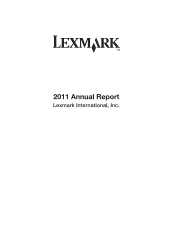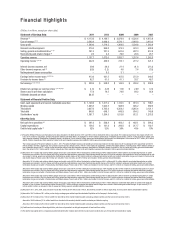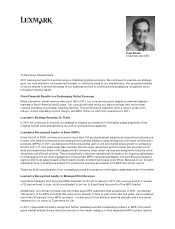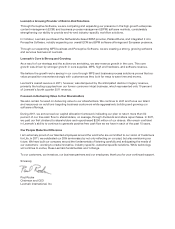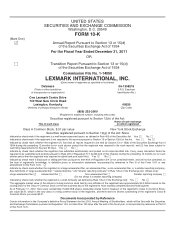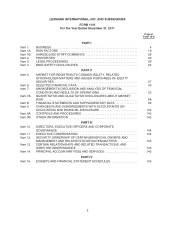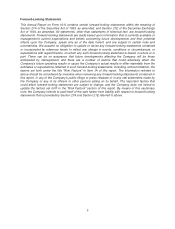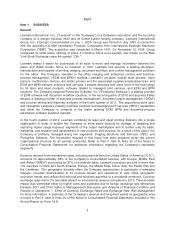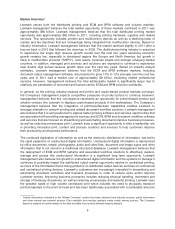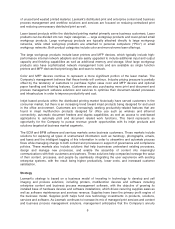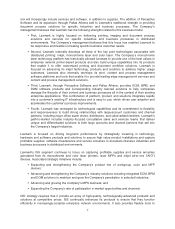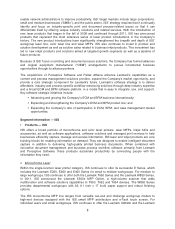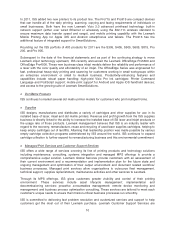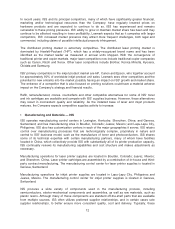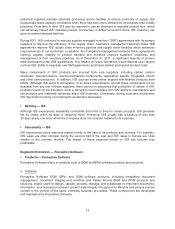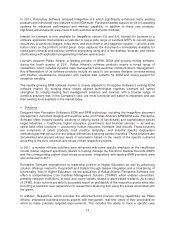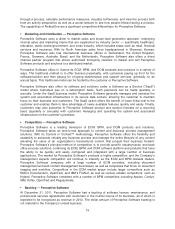Lexmark 2011 Annual Report Download - page 9
Download and view the complete annual report
Please find page 9 of the 2011 Lexmark annual report below. You can navigate through the pages in the report by either clicking on the pages listed below, or by using the keyword search tool below to find specific information within the annual report.
Market Overview1
Lexmark serves both the distributed printing and ECM and BPM software and solution markets.
Lexmark management believes the total market opportunity of these markets combined in 2011 was
approximately $90 billion. Lexmark management believes that the total distributed printing market
opportunity was approximately $82 billion in 2011, including printing hardware, supplies and related
services. This opportunity includes printers and multifunction devices as well as a declining base of
copiers and fax machines that are increasingly being integrated into multifunction devices. Based on
industry information, Lexmark management believes that the market declined slightly in 2011 after a
bounce back in 2010 that followed the downturn in 2009. The distributed printing industry is expected
to experience low single digit revenue growth overall over the next two years assuming economic
growth remains low, especially in developed regions like Europe and North America, but growth is
likely in multifunction products (“MFPs”), color lasers, business inkjets and stronger emerging market
countries. In addition, managed print services and solutions are expected to continue to experience
near double digit annual revenue growth rates over the next two years. Based on industry analyst
estimates, Lexmark management believes that the ECM and BPM software markets, including
document output management software, are projected to grow 10% to 12% annually over the next few
years and in 2011 had a market size of approximately $8 billion, excluding related professional
services. However, management believes the total addressable market is significantly larger due to
relatively low penetration of document and human-centric ECM and BPM solutions worldwide.
In general, as the printing industry matures and printer and copier-based product markets converge,
the Company’s management expects competitive pressures on product prices to continue. However,
management believes that this convergence represents an opportunity for printer-based product and
solution vendors like Lexmark to displace copier-based products in the marketplace. The Company’s
management believes that the integration of print/copy/fax/scan capabilities enables Lexmark to
leverage strengths in network printing and related document workflow solutions. Lexmark management
also believes that it is well positioned to capture faster growing software and services opportunities that
are associated with providing managed print services and ECM, BPM and document workflow software
and services that are focused on streamlining and automating document-intensive business processes,
as well as reducing unnecessary print. Lexmark sees a significant opportunity to take a leadership role
in providing innovative print, content and process solutions and services to help customers improve
their productivity and business performance.
The continued digitization of information as well as the electronic distribution of information, has led to
the rapid expansion of unstructured digital information. Unstructured digital information is represented
by office documents, emails, photographs, audio and video files, document and image scans and other
information that is not stored in a traditional structured database. Lexmark management believes that
the deployment of ECM and BPM systems and associated workflow solutions to effectively capture,
manage and access this unstructured information is a significant long term opportunity. Lexmark
management also believes the growth in unstructured digital information and the systems to manage it
continues to positively impact the distributed output market opportunity relative to centralized printing,
as more of the information that is being printed is on distributed output devices and less on commercial
and centralized printing devices. Lexmark’s customers are increasingly interested in streamlining and
automating document workflows and business processes in order to reduce costs and/or improve
customer service. Improving business processes includes reducing physical handling, movement and
storage of hardcopy documents, as well as reducing unnecessary and wasteful printing. Lexmark sees
the greatest waste in high volume centralized print which includes the need to physically transport
printed materials to the point-of-need and has been traditionally associated with considerable amounts
1Certain information contained in the “Market Overview” section has been obtained from industry sources, public information
and other internal and external sources. Data available from industry analysts varies widely among sources. The Company
bases its analysis of market trends on the data available from several different industry analysts.
5

